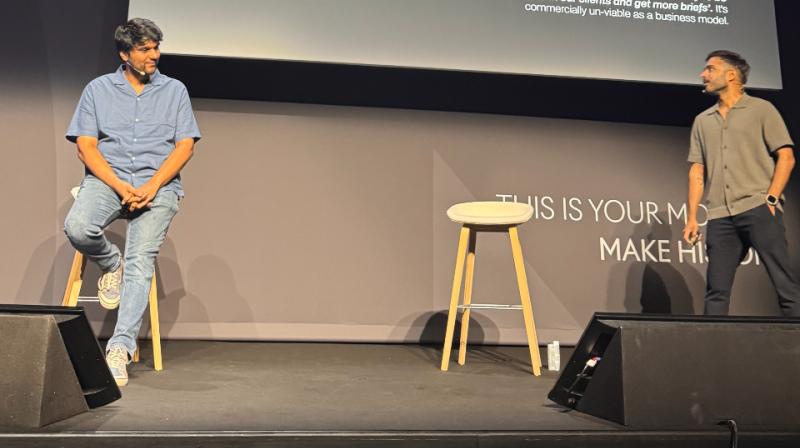On day two of the Cannes Lions International Festival of Creativity, Gautam Reghunath and PG Aditiya, co-founders, Talented took to the stage to discuss how creativity can be priced.
Starting by addressing the pitch process, the duo discussed how winning multi-agency pitches is where the fun and games end.
Reghunath stated, “You are waiting for the ideas to come to life (after the pitch) and then enter the procurement team, who are trained pricing assassinators."
He went on to add that procurement isn’t exactly an enemy as their job is to bring down pricing.
“However, if they are looking for the cheapest prices, the negotiation reduces our most valuable assets – time and creativity,” he said.
Comparing clients’ demands to entering a restaurant and ordering a dish, he said, “Clients are looking for costs like salaries, overhead costs, profit margins etc. No other industry works like this. Imagine going to a restaurant and asking for a Bolognese and then asking for a chef’s salary (to figure a price to pay for it).”
To match such pricing demands, agencies end up causing employee burnout, which means staffers are working at 1.5 to 2x of their ability.
“It’s easy to villainise one side of the scene. The reality is complex. Pricing conversations are incomplete – clients aren’t getting what they want from agencies. Pricing can go up only when they see value. There’s next to no differentiation between agencies now - pitch decks look the same and offices look the same. Ultimately, your agency’s profit margins are directly proportional to your employees’ lack of sleep,” he added.
Aditiya stated that Talented was launched to fix these issues and said that it’s had a fairly good run, thanks to experiments with pricing.
He then went down memory lane.
“1945 to 1975 was the golden era of advertising (pricing). The era that gave birth to iconic ads like Volkswagen, Avis, and Virginia Slims among others. We thrived for about 30 years because this was the era where creativity wasn’t priced separately. It was given away for free because the agency was making money on a fixed media commission. Creativity thrived under this model,” Aditiya said.
The second era he cited was between 1975 to 2004.
“It faded out in the mid-70s. Legend goes that the oil and gas industry went through a tough time and David Ogilvy had an interesting idea on how he could retain and work on the Shell business. They got rid of the media commission and wanted the client to spend money on the time the agency is giving it,” he added.
Aditiya noted that what started as a benefit for one client turned into a curse for all.
“Curses are intergenerational. It’s like 'grandpa' started it and we’re facing the consequences. Curses create a vicious circle and cripple our confidence in a bright future,” he added.
Reghunath then quoted Caroline Johnson, co-founder, The Business Model Company, to explain why the billable hour has become the advertising industry’s burning platform.
Building on Johnson's statement about 'ad agencies running an all-you-can-eat buffet for years', he added that when agencies cut poorly priced deals, they need to gain more clients. To compensate, they participate in more pitches, which often leads to even more bad deals.
“We are prioritising clients we haven’t signed up with versus those that are existing. That’s probably the reason for the substandard creativity we are seeing. And then a year later, when we’re renegotiating terms, we can’t ask for hikes. Everything wrong in the agency business can ultimately be traced back to the way we price,” he said.
Aditiya compared substandard prices to a virus.
“The virus doesn’t kill you but makes you weaker. The weakness leads to issues the industry is facing such as erosion of trust among partners, bad credit, burnout and stagnation in agencies, in-house teams, lack of long-term wealth opportunities, scam work, poor pay for freshers, sexism and ageism,” he said.
The duo offered a solution for this and labelled '2024 onwards' as the third era of advertising.
Reghunath explained, “The days where agencies had massive AOR clients don’t exist so we can’t build around them. We used to treat retainers like a subscription business which was renewed every year. Retaining clients year after year has finally become an unnecessary pressure. So, we have embraced a hybrid model, which starts with projects. A project-by-project price means different pricing for each project depending on the need.”
Aditiya added, “You need to have different prices for your commoditised services and magic offerings. We need to build brands for ourselves and these magic offerings have to be made visible to the outside world. There has to be a mystery for agencies – but build your agency to the outside world. Invest in things like BTS and showcase decks to reveal how we came up with our work.”
Getting back to the restaurant comparison, he added, “In a services business, like a restaurant – the ambience is how it’s priced. In the creative services business – similarly, everything you do is how you price yourself. If you let everyone in your agency wear a black T-shirt – that could depend on how you’re priced. If your LinkedIn post goes up with typos – that could depend on how you’re priced. How you deal with celebrities on sets – are you having conversations or are you star stuck – that could showcase how you are priced.”
While stating that mid-size agencies might not have the scale to make it a mass movement, he urged them to try it out.
“It’s a new vision for agencies in what I call the third era of advertising pricing. Can this catch up and scale? It (the earlier model) started with one shop changing for one client. So, what’s to say this can’t change the pricing model for the industry? You have to love this business and be an optimist. I’d say don’t be a large employer of average people. Be a mid-sized employer of very good people. 20-25% of the staff can’t do 80-90% of the good work. Invest one hard year for this. It will be met by rejections, but check it out,” he said.
He ended the talk by asking agencies to look at the pricing model celebrities have created.
“Clients invest so much in them because of the value-based pricing. They have created a reputation. We have a lot to learn from them. We have to look at ourselves as artists. Creatives and agencies need to have a healthy constructive ego. Look at it as a high-growth, high-risk industry rather than being conservative,” he said.












